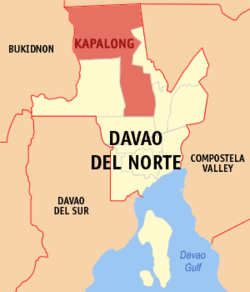Kapalong, Davao del Norte
| Kapalong | |
|---|---|
| Municipality | |
 Map of Davao del Norte with Kapalong highlighted | |
.svg.png) Kapalong Location within the Philippines | |
| Coordinates: 07°45′N 125°30′E / 7.750°N 125.500°ECoordinates: 07°45′N 125°30′E / 7.750°N 125.500°E | |
| Country | Philippines |
| Region | Davao (Region XI) |
| Province | Davao del Norte |
| District | 1st district of Davao del Norte |
| Established | July 8, 1948 |
| Barangays | 14 |
| Government[1] | |
| • Mayor | Edgardo Timbol |
| Area[2] | |
| • Total | 830.01 km2 (320.47 sq mi) |
| Population (2010)[3] | |
| • Total | 68,261 |
| • Density | 82/km2 (210/sq mi) |
| Time zone | PST (UTC+8) |
| ZIP code | 8113 |
| Dialing code | 84 |
| Income class | 1st |
Kapalong is a first class municipality in the province of Davao del Norte, Philippines. According to the 2010 census, it has a population of 68,261 people.[3]
History
The town was founded in July 8, 1948, from the Municipal District of Tagum, which was formed in 1918. It was one of the oldest towns in Davao del Norte Province, others being Tagum, in 1941; and Panabo, in 1949, both of which were converted into cities almost 50 years later. Though the towns of Santo Tomas, Talaingod and portion of San Isidro emerged from Kapalong in 1959, 1991, and 2004 respectively, it is still the largest town by land area in the province of Davao del Norte.
Barangays
Kapalong is politically subdivided into 14 barangays.[2]
- Semong
- Florida
- Gabuyan
- Gupitan
- Capungagan
- Katipunan
- Luna
- Mabantao
- Mamacao
- Pag-asa
- Maniki (Poblacion)
- Sampao
- Sua-on
- Tiburcia
Demographics
| Population census of Kapalong | ||
|---|---|---|
| Year | Pop. | ±% p.a. |
| 1990 | 66,030 | — |
| 1995 | 62,183 | −1.12% |
| 2000 | 63,650 | +0.50% |
| 2007 | 61,763 | −0.41% |
| 2010 | 68,261 | +3.71% |
| 1990 census includes Talaingod and San Isidro. 1995 and 2000 census includes San Isidro. Source: National Statistics Office[3] | ||
References
- ↑ "Official City/Municipal 2013 Election Results". Intramuros, Manila, Philippines: Commission on Elections (COMELEC). 1 July 2013. Retrieved 5 September 2013.
- 1 2 "Province: Davao del Norte". PSGC Interactive. Makati City, Philippines: National Statistical Coordination Board. Retrieved 29 April 2014.
- 1 2 3 "Total Population by Province, City, Municipality and Barangay: as of May 1, 2010" (PDF). 2010 Census of Population and Housing. National Statistics Office. Retrieved 29 April 2014.
External links
- Philippine Standard Geographic Code
- Philippine Census Information
- Local Governance Performance Management System
 |
Loreto, Agusan del Sur |  | ||
| San Fernando, Bukidnon Talaingod |
|
Laak, Compostela Valley San Isidro Asuncion | ||
| ||||
| | ||||
| Santo Tomas |
This article is issued from Wikipedia - version of the 2/16/2016. The text is available under the Creative Commons Attribution/Share Alike but additional terms may apply for the media files.